Jenn-air JFX2897DRM Installation

INSTALLATION INSTRUCTIONS AND OWNER’S MANUAL
Bottom Mount Refrigerator
Do Not Throw Away — Additional important safety information included.
Para las instrucciones en español, visite nuestro sitio de internet.
INSTRUCTIONS D’INSTALLATION ET MANUEL D’UTILISATION
Réfrigérateur avec porte à double battant et congélateur en bas
Ne pas jeter — Autres consignes de sécurité importantes ci-jointes.
Table of Contents / Table des matières
REFRIGERATOR SAFETY..................................................................... |
2 |
Proper Disposal of Your Old Refrigerator........................................... |
3 |
INSTALLATION INSTRUCTIONS ......................................................... |
3 |
Unpack the Refrigerator...................................................................... |
3 |
Remove and Replace Refrigerator Doors........................................... |
4 |
Remove and Replace Drawer Fronts.................................................. |
6 |
Location Requirements....................................................................... |
8 |
Electrical Requirements ...................................................................... |
9 |
Water Supply Requirements............................................................... |
9 |
Connect the Water Supply.................................................................. |
9 |
Handle Installation and Removal ...................................................... |
11 |
Refrigerator Leveling, Door Closing and Alignment ......................... |
12 |
FILTERS AND ACCESSORIES ........................................................... |
13 |
Water Filtration System..................................................................... |
13 |
Install Air Filter (on some models)..................................................... |
14 |
REFRIGERATOR USE ......................................................................... |
15 |
Opening and Closing Doors.............................................................. |
15 |
REFRIGERATOR CARE....................................................................... |
15 |
Cleaning ............................................................................................ |
15 |
Lights................................................................................................. |
16 |
Vacation and Moving Care ............................................................... |
16 |
PROBLEM SOLVER............................................................................. |
17 |
WATER FILTER CERTIFICATIONS .................................................... |
22 |
PERFORMANCE DATA SHEET.......................................................... |
23 |
SÉCURITÉ DU RÉFRIGÉRATEUR ..................................................... |
24 |
Mise au rebut adéquate de votre vieux réfrigérateur ....................... |
25 |
INSTRUCTIONS D’INSTALLATION ................................................... |
25 |
Déballage du réfrigérateur ................................................................ |
25 |
Retrait et réinstallation des portes du réfrigérateur.......................... |
26 |
Retrait et réinstallation de l'avant des tiroirs .................................... |
28 |
Exigences d'emplacement ............................................................... |
30 |
Spécifications électriques................................................................. |
31 |
Spécifications de l’alimentation en eau............................................ |
31 |
Raccordement à la canalisation d'eau ............................................. |
31 |
Installation et démontage des poignées .......................................... |
33 |
Mise à niveau du réfrigérateur, |
|
fermeture et alignement des portes ................................................. |
34 |
FILTRES ET ACCESSOIRES............................................................... |
36 |
Système de filtration d'eau............................................................... |
36 |
Installation du filtre à air.................................................................... |
37 |
UTILISATION DU RÉFRIGÉRATEUR................................................. |
38 |
Ouverture et fermeture des portes ................................................... |
38 |
ENTRETIEN DU RÉFRIGÉRATEUR ................................................... |
38 |
Nettoyage.......................................................................................... |
38 |
Lampes ............................................................................................. |
39 |
Entretien avant les vacances ou lors d’un déménagement ............. |
40 |
RÉSOLUTION DE PROBLÈMES ........................................................ |
41 |
FEUILLE DE DONNÉES SUR LA PERFORMANCE .......................... |
47 |
W10538548A
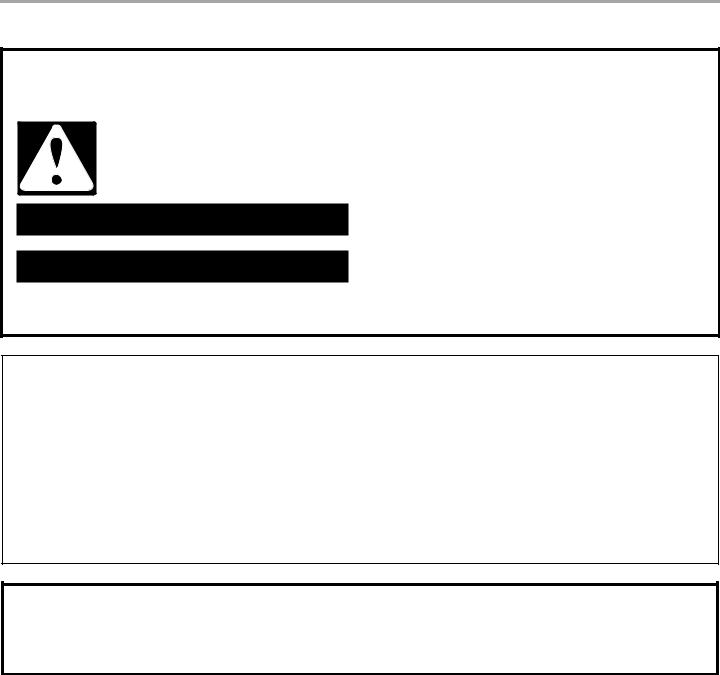
REFRIGERATOR SAFETY
Your safety and the safety of others are very important.
We have provided many important safety messages in this manual and on your appliance. Always read and obey all safety messages.
This is the safety alert symbol.
This symbol alerts you to potential hazards that can kill or hurt you and others.
All safety messages will follow the safety alert symbol and either the word “DANGER” or “WARNING.” These words mean:
 DANGER
DANGER
 WARNING
WARNING
You can be killed or seriously injured if you don't immediately follow instructions.
You can be killed or seriously injured if you don't follow instructions.
All safety messages will tell you what the potential hazard is, tell you how to reduce the chance of injury, and tell you what can happen if the instructions are not followed.
IMPORTANT SAFETY INSTRUCTIONS
WARNING: To reduce the risk of fire, electric shock, or injury when using your refrigerator, follow these basic precautions:
■ Plug into a grounded 3 prong outlet. |
■ Use nonflammable cleaner. |
|
■ Do not remove ground prong. |
■ Keep flammable materials and vapors, such as gasoline, |
|
■ Do not use an adapter. |
away from refrigerator. |
|
■ Use two or more people to move and install refrigerator. |
||
■ Do not use an extension cord. |
||
■ Disconnect power before installing ice maker (on ice maker |
||
■ Disconnect power before servicing. |
||
kit ready models only). |
||
■ Replace all parts and panels before operating. |
||
■ Use a sturdy glass when dispensing ice (on some models). |
||
■ Remove doors from your old refrigerator. |
||
■ Do not hit the refrigerator glass doors (on some models). |
||
|
SAVE THESE INSTRUCTIONS
State of California Proposition 65 Warnings:
WARNING: This product contains one or more chemicals known to the State of California to cause cancer.
WARNING: This product contains one or more chemicals known to the State of California to cause birth defects or other reproductive harm.
2
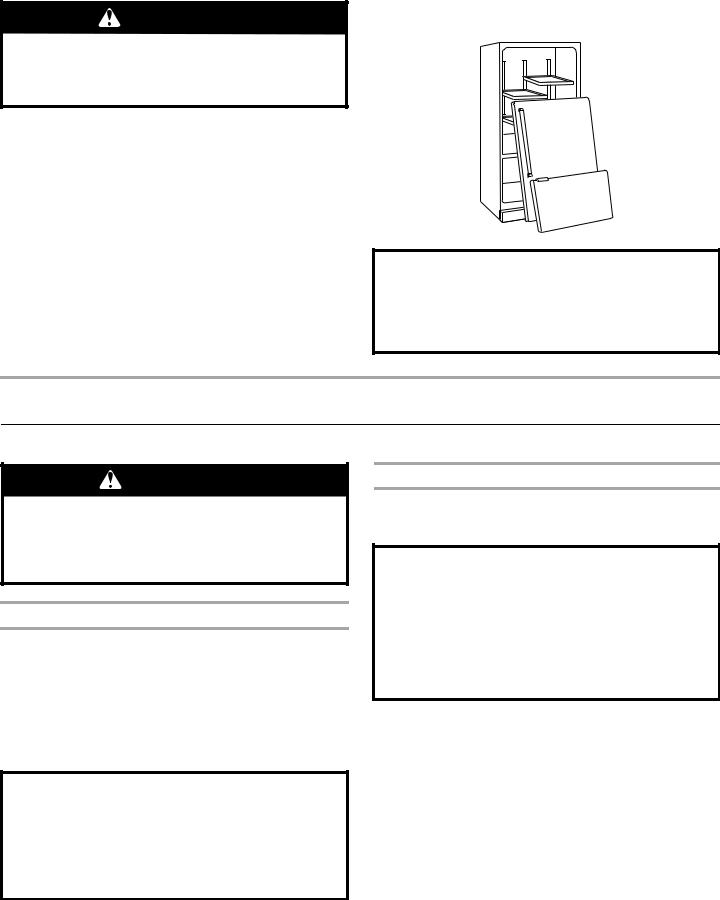
Proper Disposal of Your Old Refrigerator
WARNING
Suffocation Hazard
Remove doors from your old refrigerator.
Failure to do so can result in death or brain damage.
IMPORTANT: Child entrapment and suffocation are not problems of the past. Junked or abandoned refrigerators are still dangerous
– even if they will sit for “just a few days.” If you are getting rid of your old refrigerator, please follow these instructions to help prevent accidents.
Before You Throw Away Your Old Refrigerator or Freezer:
■Take off the doors.
■Leave the shelves in place so that children may not easily climb inside.
Important information to know about disposal of refrigerants:
Dispose of refrigerator in accordance with Federal and Local regulations. Refrigerants must be evacuated by a licensed, EPA certified refrigerant technician in accordance with established procedures.
INSTALLATION INSTRUCTIONS
Unpack the Refrigerator
WARNING
Excessive Weight Hazard
Use two or more people to move and install refrigerator.
Failure to do so can result in back or other injury.
Remove the Packaging
■Remove tape and glue residue from surfaces before turning on the refrigerator. Rub a small amount of liquid dish soap over the adhesive with your fingers. Wipe with warm water and dry.
■Do not use sharp instruments, rubbing alcohol, flammable fluids, or abrasive cleaners to remove tape or glue. These products can damage the surface of your refrigerator. For more information, see “Refrigerator Safety.”
■Dispose of/recycle all packaging materials.
When Moving Your Refrigerator:
Your refrigerator is heavy. When moving the refrigerator for cleaning or service, be sure to cover the floor with cardboard or hardboard to avoid floor damage. Always pull the refrigerator straight out when moving it. Do not wiggle or “walk” the refrigerator when trying to move it, as floor damage could occur.
Clean Before Using
After you remove all of the packaging materials, clean the inside of your refrigerator before using it. See the cleaning instructions in “Refrigerator Care.”
Important information to know about glass shelves and covers:
Do not clean glass shelves or covers with warm water when they are cold. Shelves and covers may break if exposed to sudden temperature changes or impact, such as bumping. Tempered glass is designed to shatter into many small, pebble-size pieces. This is normal. Glass shelves and covers are heavy. Use both hands when removing them to avoid dropping.
3
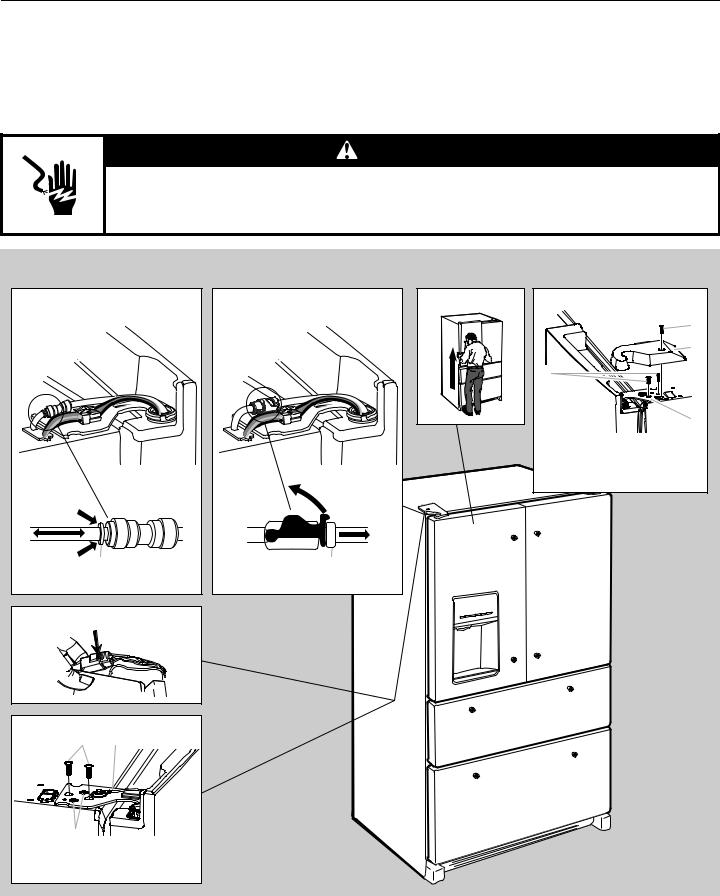
Remove and Replace Refrigerator Doors
NOTE: Measure the width of your door opening, to see whether or not you need to remove the refrigerator doors to move the refrigerator into your home. If door removal is necessary, see the following instructions.
IMPORTANT: If the refrigerator was previously installed and you are moving it out of the home, before you begin, turn the refrigerator control OFF. Unplug the refrigerator or disconnect power. Remove food and adjustable door or utility bins from doors.
Gather the required tools and read all instructions before removing doors. TOOLS NEEDED: ³⁄" hex key wrench and a #2 Phillips screwdriver
 WARNING
WARNING
Electrical Shock Hazard
Disconnect power before removing doors.
Failure to do so can result in death or electrical shock.
Style 1 – Water Dispenser |
Tubing Connection |
A |
A. Outer Ring |
Wiring Plug
Door Removal and Replacement |
|
|
Style 2 – Water Dispenser |
Door Removal |
Top Right Hinge |
Tubing Connection |
|
B |
|
|
|
|
|
C |
|
|
A |
|
|
D |
|
|
A. ³⁄" Internal Hex-Head Screws |
|
|
B. Hinge Cover Screw |
|
|
C. Top Hinge Cover |
|
|
D. Top Hinge |
A |
|
|
A. Outer Ring |
|
|
Top Left Hinge |
|
A |
B |
C |
|
A. ³⁄" Internal Hex-Head Screws |
|
B. Ground Wire (Do Not Remove) |
|
C. Do Not Remove Screws |
|
4
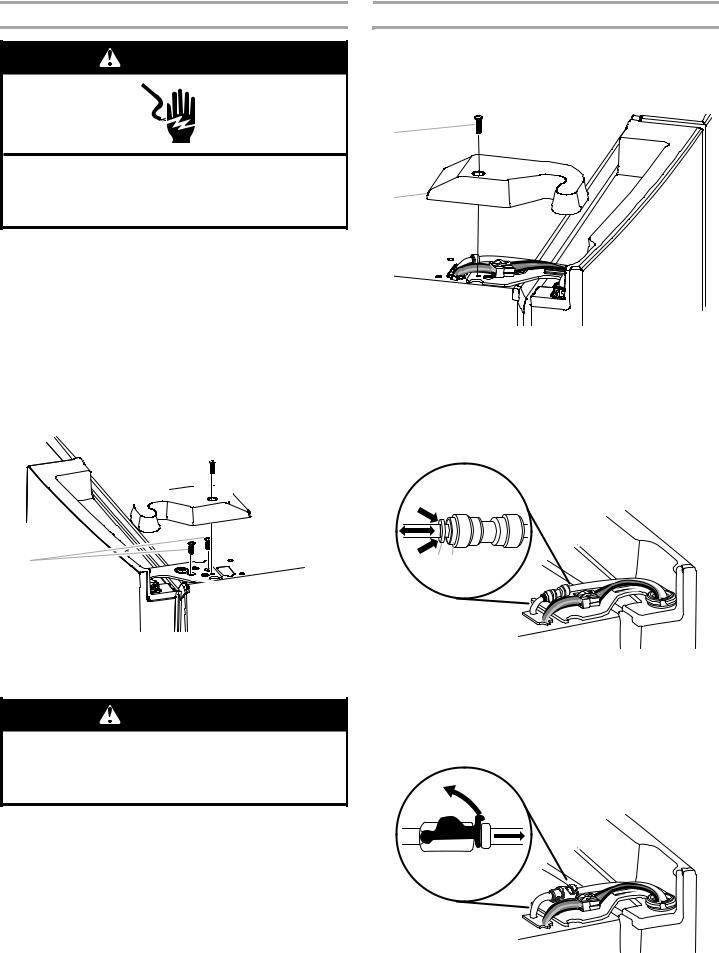
Remove Right-Hand Refrigerator Door
WARNING
Hazard
Disconnect power before removing doors.
Failure to do so can result in death or electrical shock.
1.Unplug refrigerator or disconnect power.
2.Keep the refrigerator doors closed until you are ready to lift them free from the cabinet.
NOTE: Provide additional support for the refrigerator door while the hinges are being removed. Do not depend on the door gasket magnets to hold the door in place while you are working.
3.Using a Phillips screwdriver, remove the cover from the Top Hinge.
4.Using the ³⁄" hex key wrench, remove the two internal hex head screws from the top hinge, and set aside.
NOTE: Do not remove the two locator screws. These screws will help you align the hinge when you replace the door.

 A
A




 B
B
C
 D
D
A. Top hinge cover screw |
C. ³⁄" Internal hex head screws |
B. Top hinge cover |
D. Top hinge |
WARNING
Excessive Weight Hazard
Use two or more people to lift the refrigerator door. Failure to do so can result in back or other injury.
5.Lift the refrigerator door from the bottom hinge pin. The top hinge will come away with the door.
Remove Left-Hand Refrigerator Door
IMPORTANT: The tubing and wiring for the water dispenser run through the left-hand door hinge, so they must be disconnected before removing the door.
1.Using a Phillips screwdriver, remove the cover from the top hinge.
A
B
A. Top hinge cover screw |
B. Top hinge cover |
2.Disconnect the water dispenser tubing located on top of the door hinge.
Style 1 - Press the outer ring against the face of the fitting and gently pull the dispenser tubing free.
NOTE: The water dispenser tubing remains attached to the left-hand refrigerator door.
A B
A.Outer ring
B.Face of fitting
Style 2 - Firmly pull up on the clasp. Then, pull the tubing out of the fitting.
NOTE: The water dispenser tubing remains attached to the left-hand refrigerator door.
5
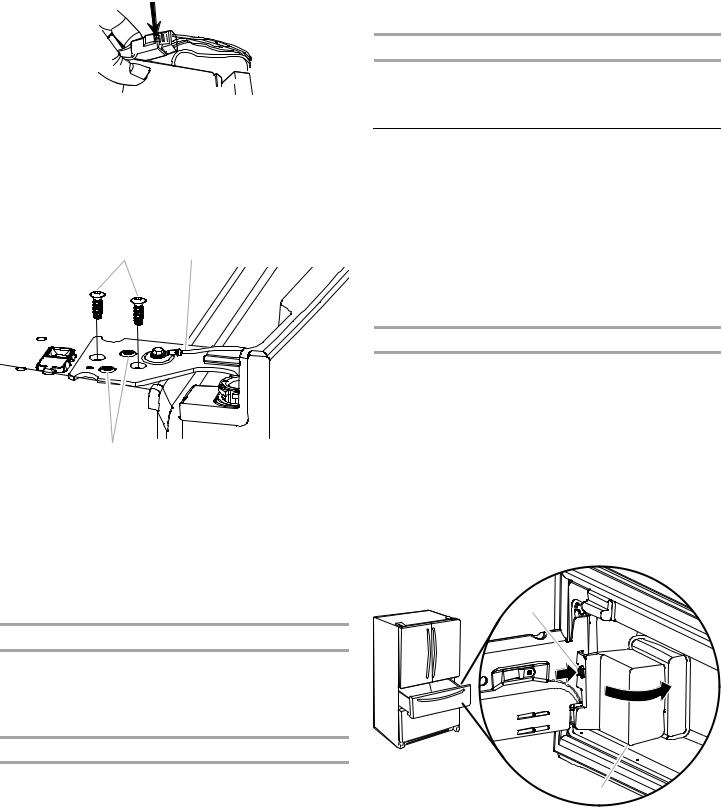
3.Disconnect the wiring plug located on top of the door hinge.
■Grasp each side of the wiring plug. With your left thumb, press down to release the catch and pull the sections of the plug apart.
NOTE: Do not remove the green, ground wire. It should remain attached to the door hinge.
4.Using the ³⁄ " hex key wrench, remove the two internal hex head screws from the top hinge, and set aside.
NOTES:
■Provide additional support for the refrigerator door while the hinges are being removed. Do not depend on the door gasket magnets to hold the door in place while you are working.
■Do not remove the two locator screws. These screws will help you align the hinge when you replace the door.
A B
C
A. ³⁄" Internal hex head screws |
C. Locator screws (do not |
B. Ground wire (do not remove) |
remove) |
5.Lift the refrigerator door from the bottom hinge pin. The top hinge will come away with the door.
NOTE: It may not be necessary to remove the bottom hinges and brake feet assemblies to move the refrigerator through a doorway.
■Only if necessary, use a driver with a #2 square bit tip to remove the bottom hinges and a ³⁄ " nut driver to remove the brake feet screws.
Replace Right-Hand Refrigerator Door
1.Set the right-hand door onto the bottom hinge pin.
2.Insert the top hinge pin into the open hole in the top of the refrigerator door.
3.Using the two ³⁄ " internal hex head screws, fasten the hinge to the cabinet. Do not tighten the screws completely.
Replace Left-Hand Refrigerator Door
IMPORTANT: Do not intertwine the water tubing and wiring bundles when reconnecting them.
1.Set the left-hand door onto the bottom hinge pin.
2.Using the two ³⁄ " internal hex head screws, fasten the hinge to the cabinet. Do not tighten the screws completely.
3.Reconnect the water dispenser tubing.
Style 1 - Insert the tubing into the fitting until it stops and the outer ring is touching the face of fitting.
Style 2 - Insert the tubing firmly into the fitting until it stops. Close the clasp around the tubing. The clasp snaps into place between the fitting and the collar.
4.Reconnect the electrical wiring.
■ Push together the two sections of the wiring plug.
Final Steps
1.Completely tighten the four internal hex head screws (two on the right-hand door hinge and two on the left-hand door hinge).
2.Replace both top hinge covers.
Remove and Replace Drawer Fronts
Depending on the width of your door opening, it may be necessary to remove the drawer fronts to move the refrigerator into your home.
IMPORTANT:
■If the refrigerator was previously installed and you are moving it out of the home, before you begin, turn the refrigerator control OFF, and unplug the refrigerator or disconnect power. Remove food from the drawers.
■Two people may be required to remove and replace the drawer fronts.
Tools Needed: ¹⁄ " Hex head nut driver, Flat-blade screwdriver
Refrigerated Drawer
Disconnect Wiring
NOTES:
■The exterior refrigerator drawer front is connected to the temperature control. Before removing the drawer front, the wires must be disconnected from the temperature control.
■The cable visible behind and under the pantry drawer at the right side contains wiring for the pantry control and moves with the drawer as it is pulled out. There is no need to disconnect this cable.
1.Open the drawer to its full extension, and remove the large interior bin.
2.Locate the wiring cover on the backside of the drawer front. Press tab on the cover to release the snaps, and pull off cover to reveal the wiring connection.
A
B
A. Press tab |
B. Wiring connection cover |
6
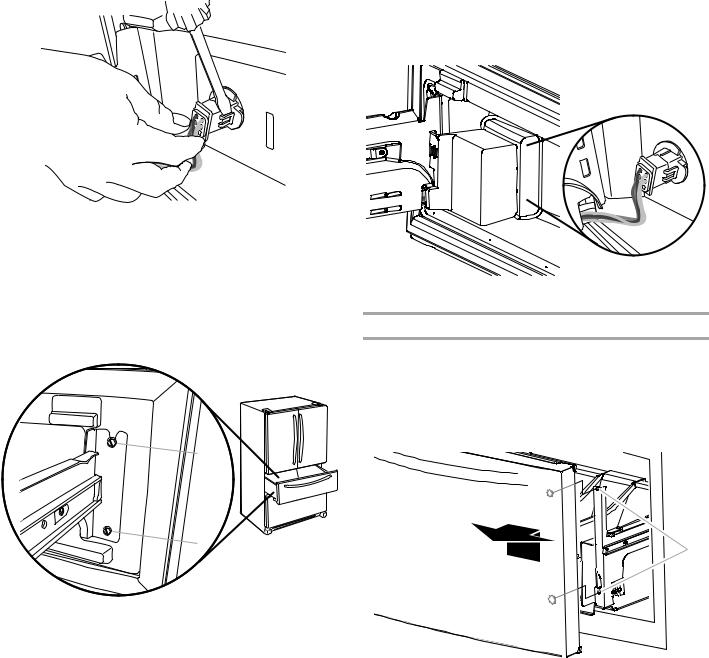
3.On one side of the wiring connector, insert the screwdriver blade between the connector tab and the connector to release. Repeat for the opposite side. Pull the wiring connector apart.
Remove Drawer Front
1.Using a ¹⁄ " hex head nut driver, remove the two bottom screws (one on each side) attaching the drawer front to the drawer glides.
2.Using ¹⁄ " hex head nut driver, loosen the two top screws (one on each side) attaching the drawer front to the drawer glides.
NOTE: Loosen the screws three to four turns. Keep the screws in the drawer front.
3.Lift the drawer front up and off the drawer glide brackets.
 A
A
 B
B
 C
C
A. Loosen top screws |
C. Remove bottom screws |
B.Drawer glide bracket
4.Slide the drawer glides back into the refrigerator.
Replace Drawer Front
1.Pull out the drawer glides until they are fully extended.
2.Lower the loosened screws in the top of the drawer front into the upper notches in the drawer glides.
NOTE: It helps if one person holds the drawer glides steady while another person aligns the drawer front and inserts the screws into the notches.
3.Align the holes in the bottom of the drawer front with the holes in the bottom of the drawer glides and fasten with the screws removed earlier.
4.Tighten the two top screws.
Reconnect Wiring
1.Align the two ends of the wiring connector and push them together until you hear a “click” sound and feel the tabs snap into place on the connector.
2.Gently pull on the wiring connection to ensure the wiring connection is completely seated. Replace the wiring cover.
NOTE: The wiring connection must be complete for the drawer temperature control to operate.
3.Replace the interior bin.
Freezer Drawer
Remove Drawer Front
1.Open the freezer drawer to its full extension.
2.Loosen the two top screws that fasten the drawer front to the drawer glides. The two screws (one on the left-hand side and one on the right-hand side) are located inside the drawer front.
3.Lift up on the drawer front to release the plastic studs from the drawer glide bracket slots.
A
A.Drawer glide bracket slots
4.Slide the drawer glides back into the freezer.
7
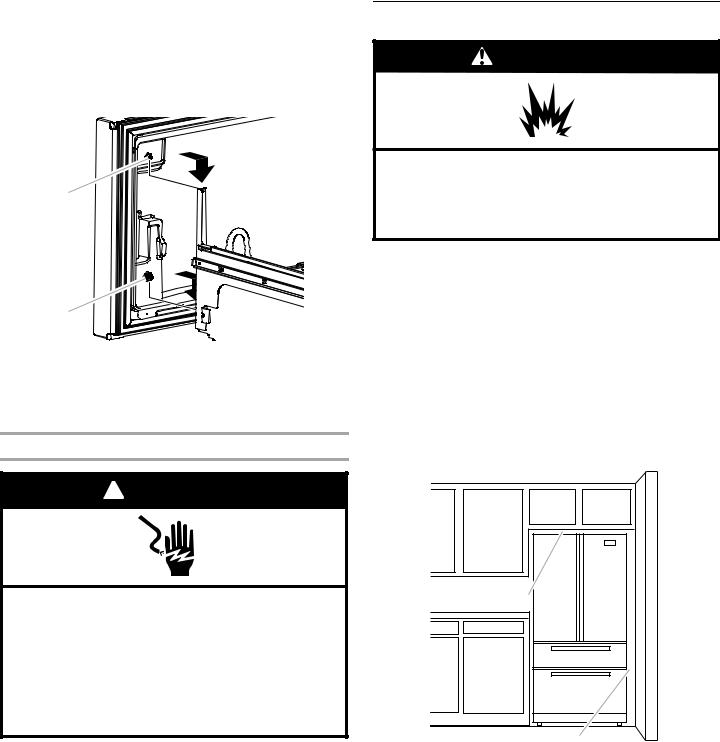
Replace Drawer Front
1.Pull out the freezer drawer glides to their full extension.
2.Holding the drawer front by its sides, align the two plastic studs, located at the bottom, inside the drawer front, with the drawer glide bracket slots.
NOTE: It helps if one person holds the drawer glides steady while another person aligns the drawer front and inserts the studs into the slots.
A
B
A.Drawer front screw
B.Drawer front plastic stud
3.Replace and tighten the two screws at the top of the drawer front (one on the left-hand side and one on the right-hand side).
Final Steps
Location Requirements
WARNING
Explosion Hazard
Keep flammable materials and vapors, such as gasoline, away from refrigerator.
Failure to do so can result in death, explosion, or fire.
IMPORTANT: This refrigerator is designed for indoor, household use only.
To ensure proper ventilation for your refrigerator, allow for a ¹⁄ " (1.25 cm) of space on each side and at the top. Allow for a 1" (2.54 cm) space behind the refrigerator. If your refrigerator has an ice maker, allow extra space at the back for the water line connections. When installing your refrigerator next to a fixed wall, leave a 3³⁄ " (9.5 cm) minimum space between the refrigerator and wall to allow the door to swing open.
NOTE: This refrigerator is intended for use in a location where the temperature ranges from a minimum of 55°F (13°C) to a maximum of 110°F (43°C). The preferred room temperature range for optimum performance, which reduces electricity usage and provides superior cooling, is between 60°F (15°C) and 90°F (32°C). It is recommended that you do not install the refrigerator near a heat source, such as an oven or radiator.
 WARNING
WARNING
Electrical Shock Hazard
Plug into a grounded 3 prong outlet.
Do not remove ground prong.
Do not use an adapter.
Do not use an extension cord.
Failure to follow these instructions can result in death, fire, or electrical shock.
1.Plug into a grounded 3 prong outlet.
2.Reset the controls. See “Using the Control(s)” and “Temperature Controlled Exterior Drawer.”
3.Return all removable parts and the food to the drawers.
¹⁄ " (1.25 cm)
3³⁄ " (9.5 cm)
8
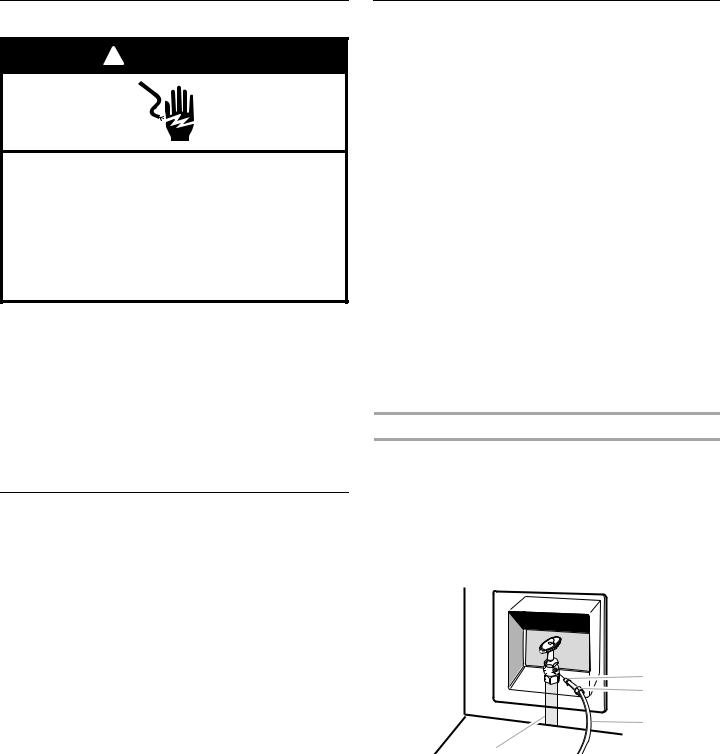
Electrical Requirements
 WARNING
WARNING
Electrical Shock Hazard
Plug into a grounded 3 prong outlet.
Do not remove ground prong.
Do not use an adapter.
Do not use an extension cord.
Failure to follow these instructions can result in death, fire, or electrical shock.
Before you move your refrigerator into its final location, it is important to make sure you have the proper electrical connection.
Recommended Grounding Method
A 115 volt, 60 Hz, AC only 15or 20-amp fused, grounded electrical supply is required. It is recommended that a separate circuit serving only your refrigerator be provided. Use an outlet that cannot be turned off by a switch. Do not use an extension cord.
NOTE: Before performing any type of installation, cleaning, or removing a light bulb, turn Cooling OFF, and then disconnect the refrigerator from the electrical source. When you have finished, reconnect the refrigerator to the electrical source and turn Cooling ON. See “Using the Control(s).”
Water Supply Requirements
A cold water supply with water pressure between 35 and 120 psi (241 and 827 kPa) is required to operate the water dispenser and ice maker. If you have questions about your water pressure, call a licensed, qualified plumber.
NOTE: If the water pressure is less than what is required, the flow of water from the water dispenser could decrease or ice cubes could be hollow or irregular shaped.
Reverse Osmosis Water Supply
IMPORTANT: The pressure of the water supply coming out of a reverse osmosis system going to the water inlet valve of the refrigerator needs to be between 35 and 120 psi (241 and
827 kPa).
If a reverse osmosis water filtration system is connected to your cold water supply, the water pressure to the reverse osmosis system needs to be a minimum of 40 to 60 psi (276 to 414 kPa).
■Check to see whether the sediment filter in the reverse osmosis system is blocked. Replace the filter if necessary.
■Allow the storage tank on the reverse osmosis system to refill after heavy use. The tank capacity could be too small to keep up with the requirements of the refrigerator.
NOTE: Faucet mounted reverse osmosis systems are not recommended.
■If your refrigerator has a water filter, it may further reduce the water pressure when used in conjunction with a reverse osmosis system. Remove the water filter. See “Water Filtration System.”
If you have questions about your water pressure, call a licensed, qualified plumber.
Connect the Water Supply
Read all directions before you begin.
IMPORTANT:
■Plumbing shall be installed in accordance with the International Plumbing Code and any local codes and ordinances.
■The gray water tubing on the back of the refrigerator (which is used to connect to the household water line) is a PEX (cross-linked polyethylene) tube. Copper and PEX tubing connections from the household water line to the refrigerator are acceptable, and will help avoid off-taste or odor in your ice or water. Check for leaks.
If PEX tubing is used instead of copper, we recommend the following Whirlpool Part Numbers:
W10505928RP (7 ft [2.14 m] jacketed PEX), 8212547RP (5 ft [1.52 m] PEX), or W10267701RP (25 ft [7.62 m] PEX).
■Install tubing only in areas where temperatures will remain above freezing.
TOOLS NEEDED:
Gather the required tools and parts before starting installation.
■Flat-blade screwdriver
■⁄ " and ¹⁄ " open-end wrenches or two adjustable wrenches
■¹⁄ " nut driver
NOTE: Do not use a piercing-type or ³⁄ " (4.76 mm) saddle valve which reduces water flow and clogs easier.
Connect to Water Line
IMPORTANT: If you turn the refrigerator on before the water is connected, turn the ice maker OFF.
1.Unplug refrigerator or disconnect power.
2.Turn OFF main water supply. Turn ON nearest faucet long enough to clear line of water.
3.Use a quarter-turn shutoff valve or the equivalent, served by a ¹⁄ " household supply line.
NOTE: To allow sufficient water flow to the refrigerator, a minimum ¹⁄ " size household supply line is recommended.
A |
B |
C
|
D |
A. Sleeve |
C. Copper tubing (to refrigerator) |
B. Nut |
D. Household supply line (½" minimum) |
9
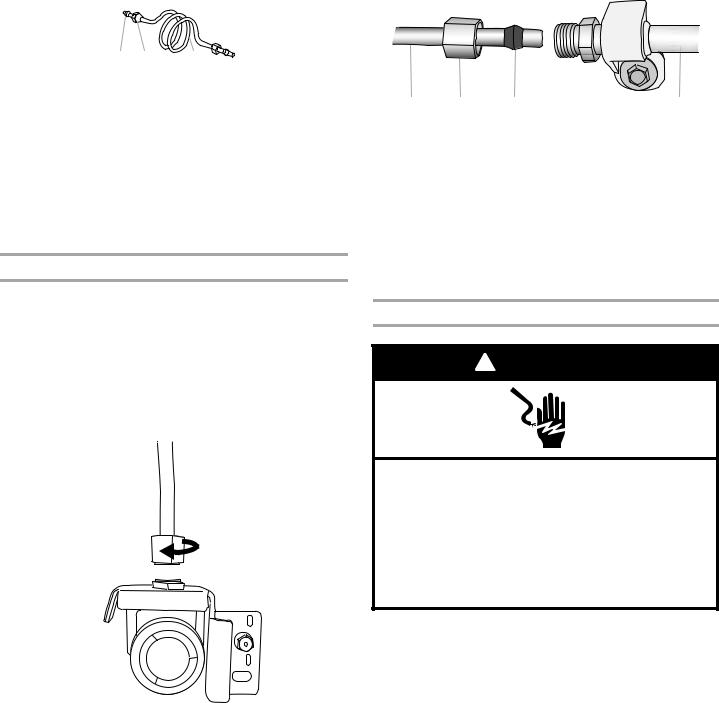
4.Now you are ready to connect the copper tubing to the shutoff valve. Use ¹⁄ " (6.35 mm) OD soft copper tubing to connect the shutoff valve and the refrigerator.
■Ensure that you have the proper length needed for the job. Be sure both ends of the copper tubing are cut square.
■Slip compression sleeve and compression nut onto copper tubing as shown. Insert end of tubing into outlet end squarely as far as it will go. Screw compression nut onto outlet end with adjustable wrench. Do not overtighten.
Style 2
1.Unplug refrigerator or disconnect power.
2.Remove and discard the short, black plastic part from the end of the water line inlet.
3.Thread the nut onto the end of the tubing. Tighten the nut by hand. Then tighten it with a wrench two more turns. Do not overtighten.
NOTE: To avoid rattling, be sure the copper tubing does not touch the cabinet’s side wall or other parts inside the cabinet.
A B |
C |
A. Compression sleeve |
C. Copper tubing |
B.Compression nut
5.Place the free end of the tubing into a container or sink, and turn on main water supply to flush out tubing until water is clear. Turn off shutoff valve on the water pipe.
NOTE: Always drain the water line before making the final connection to the inlet of the water valve, to avoid possible water valve malfunction.
6.Bend the copper tubing to meet the water line inlet, which is located on the back of the refrigerator cabinet as shown. Leave a coil of copper tubing to allow the refrigerator to be pulled out of the cabinet or away from the wall for service.
Connect to Refrigerator
Follow the connection instructions specific to your model.
Style 1
1.Remove plastic cap from water valve inlet port. Attach the copper tube to the valve inlet using a compression nut and sleeve as shown. Tighten the compression nut. Do not overtighten. Confirm copper tubing is secure by pulling on copper tubing.
2.Create a service loop with the copper tubing. Avoid kinks when coiling the copper tubing. Secure copper tubing to refrigerator cabinet with a “P” clamp.
A 
B 


C 
D 
A. Copper tubing |
C. Compression nut |
B. “P” clamp |
D. Compression sleeve |
3.Turn on water supply to refrigerator and check for leaks. Correct any leaks.
A |
B |
C |
D |
|
A. Household water line |
C. Ferrule (purchased) |
|
|
B. Nut (purchased) |
|
D. Refrigerator water tubing |
4.Install the water supply tube clamp around the water supply line to reduce strain on the coupling.
5.Turn shutoff valve ON.
6.Check for leaks. Tighten any connections (including connections at the valve) or nuts that leak.
7.On some models, the ice maker is equipped with a built-in water strainer. If your water conditions require a second water strainer, install it in the ¹⁄ " (6.35 mm) water line at either tube connection. Obtain a water strainer from your appliance dealer.
Complete the Installation
 WARNING
WARNING
Electrical Shock Hazard
Plug into a grounded 3 prong outlet.
Do not remove ground prong.
Do not use an adapter.
Do not use an extension cord.
Failure to follow these instructions can result in death, fire, or electrical shock.
1.Plug into a grounded 3 prong outlet.
2.Flush the water system. See “Water and Ice Dispensers.”
NOTE: Allow 24 hours to produce the first batch of ice. Discard the first three batches of ice produced. Allow 3 days to completely fill the ice storage bin.
10

Handle Installation and Removal
Parts Included: Refrigerator door handles (2), Refrigerator drawer handle (1), Freezer drawer handle (1), ¹⁄" hex key, spare setscrew(s)
Install Handles
Refrigerator Doors
NOTE: Handle mounting setscrews are preinstalled inside the handle.
1.Remove the handles from the packaging inside the refrigerator, and place them on a soft surface.
2.Open a refrigerator compartment door. On the closed door, place a handle onto the shoulder screws so that the setscrews are facing the adjacent door.
A
B
A.Shoulder screws
B.Setscrews inside the handle
3.Firmly push the handle toward the door until the handle base is flush against the door.
4.While holding the handle, insert the short end of the hex key into the upper hole and slightly rotate the hex key until it is engaged in the setscrew.
5.Using a clockwise motion tighten the setscrew just until it begins to contact the shoulder screw. Do not fully tighten.
6.Repeat steps 4 and 5 to fasten the lower setscrew.
7.Once both setscrews have been partially tightened as instructed in the previous steps, fully tighten both setscrews.
IMPORTANT: When the screws feel tight, tighten them an additional quarter-turn. The handle is not properly installed without this extra tightening.
8.Repeat steps 2 through 7 to install the other handle onto the adjacent refrigerator door.
Refrigerator and Freezer Drawers
1.With the drawer closed, place the handle onto the shoulder screws so that the setscrews are facing down toward the floor.
 A
A
B
A.Shoulder screw
B.Setscrews inside the handle
2.Firmly push the handle toward the drawer until the handle base is flush against the drawer.
3.Insert the short end of the hex key into the left-hand hole and slightly rotate the hex key until it is engaged in the setscrew.
4.Using a left to right motion tighten the setscrew a quarter-turn at a time just until it begins to contact the shoulder screw. Do not fully tighten.
5.Repeat steps 11 and 12 to fasten the right-hand setscrew to the shoulder screw.
6.Once both setscrews have been partially tightened as instructed in the previous steps, fully tighten both setscrews.
IMPORTANT: When the screws feel tight, tighten them an additional quarter-turn. The handle is not properly installed without this extra tightening.
7.Save the hex key and all instructions.
Remove the Handles
1.While holding the handle, insert the short end of the hex key into a setscrew hole and slightly rotate the hex key until it is engaged in the setscrew.
2.Using a right to left motion loosen the setscrew a quarter-turn at a time.
3.Repeat steps 1 and 2 for the other setscrew. Slowly pull the handle away from the door or drawer.
4.If necessary, use a Phillips screwdriver to remove the shoulder screws from the door.
11
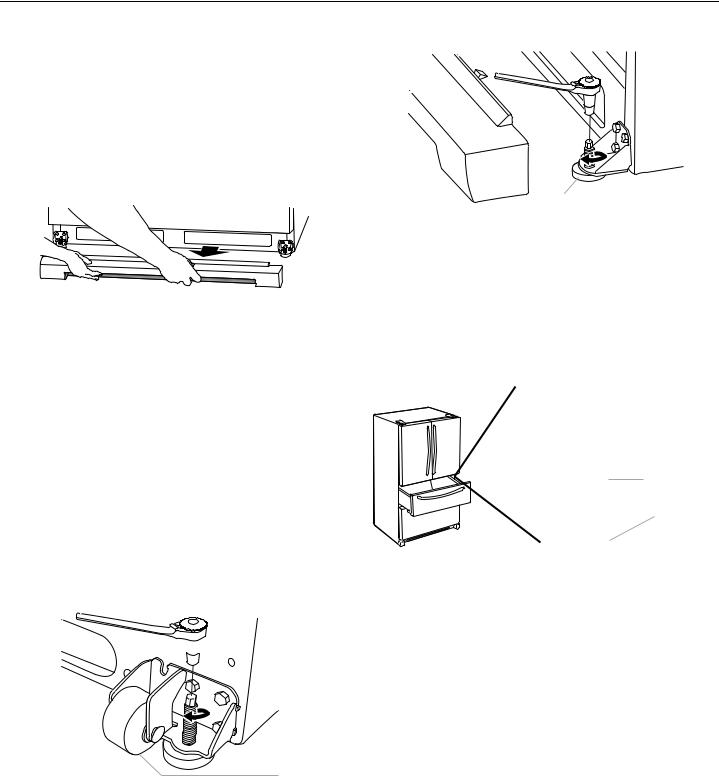
Refrigerator Leveling, Door Closing and Alignment
The base grille covers the adjustable brake feet and roller assemblies located at the bottom of the refrigerator below the freezer drawer. Before making any adjustments, remove the base grille and move the refrigerator to its final location.
Tools Needed: ¹⁄ " hex nut driver
Tools Provided: ¹⁄ " hex key wrench
1.Remove the base grille. Using both hands, grasp the grille firmly and pull it toward you. Open the freezer drawer to access the brake feet.
NOTE: To allow the refrigerator to roll easier, raise the break feet by turning them counterclockwise. The front rollers will be touching the floor.
2.Move the refrigerator to its final location.
3.Using the ¹⁄ " hex nut driver, lower the brake feet. Turn them clockwise, until the rollers are off the floor and both brake feet are snug against the floor. This keeps the refrigerator from rolling forward when opening the refrigerator doors or freezer drawer.
IMPORTANT: If you need to make further adjustments involving the brake feet, you must turn both brake feet the same amount to keep the refrigerator level.
4.Make sure the doors close easily. If you are satisfied with the door opening and closing, skip the next section and go to “Align the Doors.” If, however, the doors do not close easily or the doors pop open, adjust the tilt.
To Adjust the Cabinet Tilt:
■Open the freezer drawer. Use a ¹⁄ " hex nut driver to turn both brake feet clockwise the same amount. This will raise the front of the refrigerator. It may take several turns to allow the doors to close easier.
NOTE: Having someone push against the top of the refrigerator takes some weight off the brake feet. This makes it easier to turn them.
Style 1
 ¹⁄"
¹⁄"
 A
A
B
A.Brake foot
B.Front roller
Style 2
A
A.Brake foot
5.Make sure the doors are even at the top and that the space between the bottom of the refrigerator doors and the top of the freezer drawer is even. If necessary, align the doors.
To Align the Doors:
■Keeping both refrigerator doors closed, pull out the refrigerated drawer. Locate the bottom hinge pin of the right-hand refrigerator door. The alignment screw is inside the bottom hinge pin.
A 

B
C 
D
A.Bottom hinge pin
B.Turn to the right to raise.
C.Turn to the left to lower.
D.¹⁄" Hex key wrench
■Insert the short end of the ¹⁄ " hex key wrench (packed with the Door Handle Installation Instructions) into the bottom hinge pin until it is fully engaged in the alignment screw.
To raise the door, turn the hex key to the right. To lower the door, turn the hex key to the left.
■Continue to turn the alignment screw until the doors are aligned.
6.Make sure the refrigerator is steady. If the refrigerator seems unsteady or rolls forward when a door or drawer is pulled open, adjust the brake feet.
To Steady the Refrigerator:
■Open the freezer drawer. Using a ¹⁄ " hex driver, turn both brake feet clockwise the same amount until the brake feet are snug against the floor. Check again. If not satisfied, continue to adjust the brake feet by half turns of the screw until the refrigerator does not roll forward when the drawer is opened.
NOTE: Having someone push against the top of the refrigerator takes some weight off the brake feet. This makes it easier to turn the screws.
7.Replace the base grille by aligning the ends of the grille with the leveling assemblies on each side and snapping the grille into place.
12
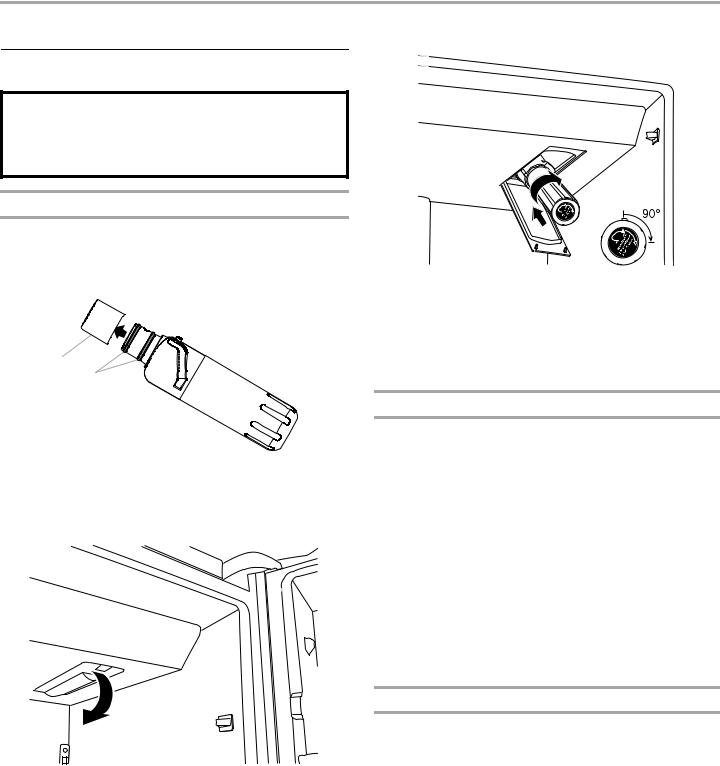
FILTERS AND ACCESSORIES
Water Filtration System
Do not use with water that is microbiologically unsafe or of unknown quality without adequate disinfection before or after the system. Systems certified for cyst reduction may be used on disinfected waters that may contain filterable cysts.
Install the Water Filter
1.Locate the accessory packet in the refrigerator and remove the water filter.
2.Take the water filter out of its packaging and remove the cover from the O-rings. Be sure the O-rings are still in place after the cover is removed.
A
B
A.O-ring cover
B.O-rings
3.The water filter compartment is located in the right-hand side of the refrigerator ceiling. Push up on the compartment door to release the catch, then lower the door.
4.Align the arrow on the water filter label with the cutout notch in the filter housing and insert the filter into the housing.
5.Turn the filter clockwise 90 degrees (¹⁄ turn), until it locks into the housing.
NOTE: If the filter is not correctly locked into the housing, the water dispenser will not operate. Water will not flow from the dispenser.
6.While the compartment door is still open, lift the filter up into the compartment. Then, close the filter compartment door completely.
7.Flush the water system. See “Flushing the Water Filter” in the “Water and Ice Dispensers” section.
IMPORTANT: If you do not flush the water system, you may experience dripping and/or decreased flow from the water dispenser.
The Water Filter Status Light
Press OPTIONS on the control panel to launch the Options menu. Press OPTIONS, under Filter Status, again to display the percentage of filter life remaining (from 99% to 0%). Press ICE/ WATER, under Back, to return to the Normal screen.
The water filter status lights will help you know when to change your water filter.
■ORDER FILTER (yellow) - it is almost time to change the water filter. While you are dispensing water, “Order Filter” will blink seven times and sound an alert tone three times.
■REPLACE FILTER (red) - Replace the water filter. While you are dispensing water, “Replace Filter” will blink seven times and an alert tone will sound three times.
■RESET the water filter status tracking feature. After you replace the disposable filter with a new filter, closing the filter compartment door will automatically reset the filter status tracking feature. See “Using the Control(s).”
NOTE: “REPLACE FILTER” will remain illuminated if a filter is not installed or is installed incorrectly.
Replace the Water Filter
To purchase a replacement water filter, see “Accessories” in the User Guide, Use and Care Guide or User Instructions.
Replace the disposable water filter when indicated on the water filter status display or at least every 6 months. If water flow to your dispenser or ice maker decreases noticeably, change the water filter sooner.
1.Locate the water filter compartment in the right-hand side of the refrigerator ceiling. Push up to release and lower the compartment door.
2.Turn the water filter counterclockwise (to the left), and pull it straight out of the compartment.
NOTE: There may be some water in the filter. Some spilling may occur. Use a towel to wipe up any spills.
3.Install the replacement water filter by following steps 2 through 7 in the “Install the Water Filter” section.
13
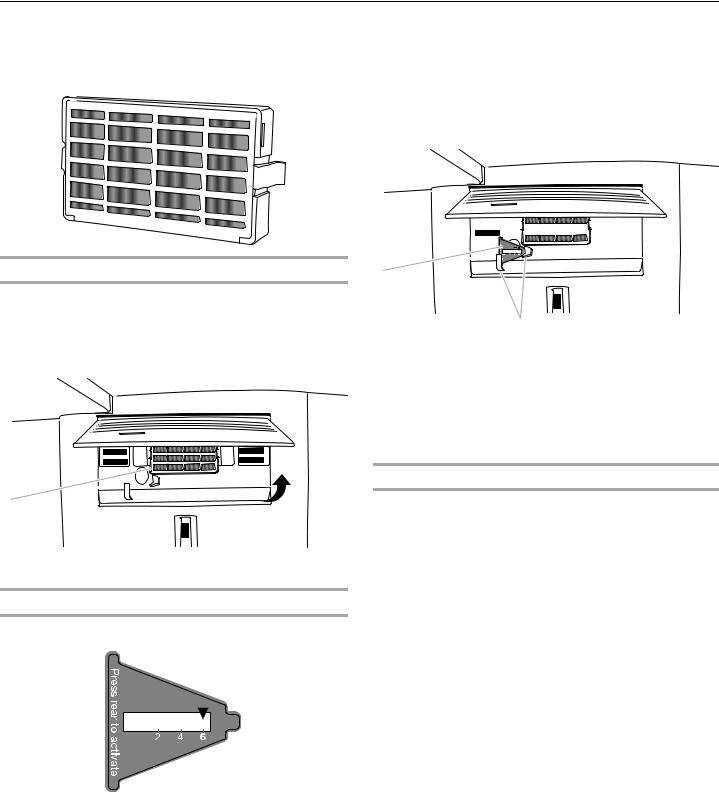
Install Air Filter (on some models)
An air filter is 15 times more powerful than baking soda at reducing common food odors inside the refrigerator.
On some models, your refrigerator's accessory packet includes an air filter, which must be installed prior to use.
Installing the Air Filter
Install the air filter behind the vented door, located on the rear wall near the top of the refrigerator compartment.
1.Remove the air filter from its packaging.
2.Lift open the vented door.
3.Snap the filter into place.
A
A. Air filter
Installing the Filter Status Indicator
The filter comes with a status indicator, which should be activated and installed at the same time the air filter is installed.
REPLACE
MONTHS
Models with notches:
■With the indicator screen facing outward, slide the indicator down into the notches.
NOTE: The indicator will not easily slide into the notches if the bubble has not been popped.
■Close the air filter door, and check that the indicator is visible through the window in the door.
A 







B
C
A.Status indicator window
B.Air filter status indicator
C.Notches
Models without notches:
■Place the indicator somewhere it is easily visible - either inside the refrigerator, or elsewhere in your kitchen or home.
Replacing the Air Filter
The disposable air filter should be replaced every 6 months, when the status indicator has completely changed from white to red.
To order a replacement air filter, contact us. See “Accessories” in the User Guide, Use and Care Guide or User Instructions for information on ordering.
1.Remove the used air filter by squeezing in on the side tabs.
2.Remove the used status indicator.
3.Install the new air filter and filter status indicator using the instructions in the previous sections.
1.Place the indicator face-down on a firm, flat surface.
2.Apply pressure to the bubble on the back of the indicator until the bubble pops to activate the indicator.
3.Lift open the vented air filter door. On some models, there are notches behind the door.
14
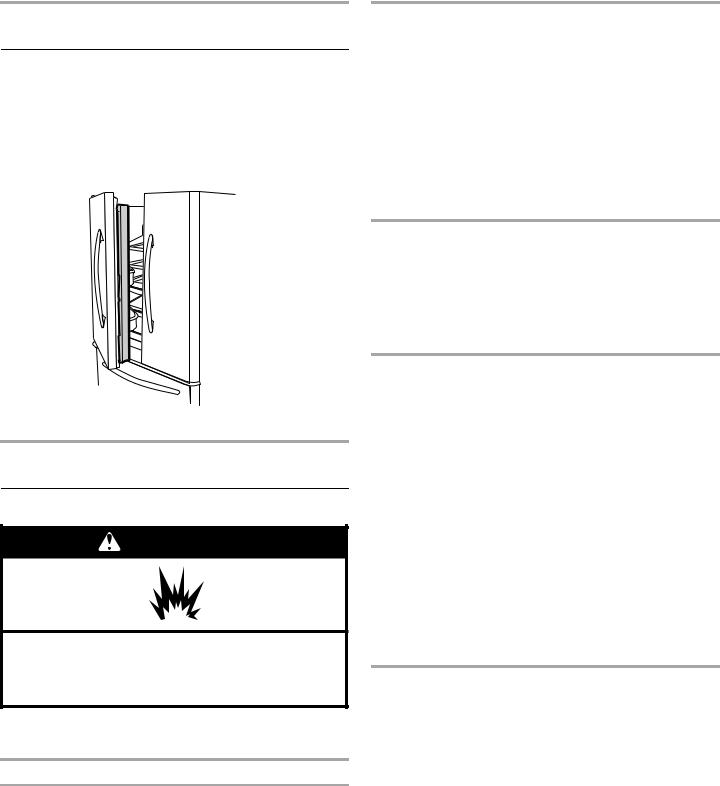
REFRIGERATOR USE
Opening and Closing Doors
There are two refrigerator compartment doors. The doors can be opened and closed either separately or together.
There is a vertically-hinged seal on the left refrigerator door.
■When the left side door is opened, the hinged seal automatically folds inward so that it is out of the way.
■When both doors are closed, the hinged seal automatically forms a seal between the two doors.
 A
A
A. Hinged seal
REFRIGERATOR CARE
Cleaning
WARNING
Use nonflammable
Failure to do so can result in death, explosion, or fire.
Both the refrigerator and freezer sections defrost automatically. However, clean both sections about once a month to avoid buildup of odors. Wipe up spills immediately.
Exterior Cleaning
Please see the exterior cleaning information specific to your model.
Style 1 - Smooth Door
IMPORTANT: Damage to smooth finish due to improper use of cleaning products, or using non-recommended cleaning products, is not covered under the warranty. Sharp or blunt instruments will mar the finish.
DO USE |
|
DO NOT USE |
|
|
|
Soft, clean cloth |
|
Abrasive cloths |
|
Paper towels or newsprint |
|
|
Steel-wool pads |
|
|
|
|
Warm, soapy water - |
|
Abrasive powders or liquids |
use a mild detergent |
|
Window sprays |
|
||
|
|
Ammonia |
|
Acidic or vinegar based |
|
|
|
cleaners |
|
|
Oven cleaners |
|
|
Flammable fluids |
NOTE: Paper towels scratch and may dull the clear coat of the painted door. To avoid possible damage use only soft clean clothes to polish and wipe the door.
Style 2 - Stainless Steel
IMPORTANT:
■Damage to stainless steel finish due to improper use of cleaning products, or using non-recommended cleaning products, is not covered under the warranty.
DO USE |
|
DO NOT USE |
|
|
|
Soft, clean cloth |
|
Abrasive cloths |
|
Paper towels or newsprint |
|
|
Steel-wool pads |
|
|
|
|
Warm, soapy water |
|
Abrasive powders or liquids |
|
|
Ammonia |
|
Citrus-based cleaners |
|
|
Acidic or vinegar-based |
|
|
|
cleaners |
|
|
Oven cleaners |
|
|
|
For heavy soil, ONLY |
|
Stainless steel cleaner is for |
a stainless steel |
|
stainless steel parts only! Do |
cleaner designed for |
|
not allow the Stainless Steel |
appliances. To order |
|
Cleaner and Polish to come |
the cleaner, see |
|
into contact with any plastic |
“Accessories.” |
|
parts such as the trim pieces, |
|
|
dispenser covers or door |
|
|
gaskets. |
NOTES:
■If unintentional contact does occur, clean plastic part with a sponge and mild detergent in warm water. Dry thoroughly with a soft cloth.
■Just because a cleaner is a liquid does not mean it is nonabrasive. Many liquid cleansers formulated to be gentle on tile and smooth surfaces still damage stainless steel.
■Citric acid permanently discolors stainless steel. To avoid damaging the finish of your stainless steel refrigerator:
Do not allow these substances to remain on the finish
|
Mustard |
|
Citrus-based sauces |
|
Tomato juice |
|
Citrus-based products |
Marinara sauce
15
